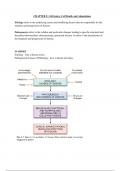CHAPTER 2: Cell Injury, Cell Death, and Adaptations
Etiology refers to the underlying causes and modifying factors that are responsible for the
initiation and progression of disease.
Pathogenesis refers to the cellular and molecular changes leading to specific structural and
functional abnormalities characterizing a particular disease. It refers to the mechanisms of
development and progression of disease.
IN SHORT
Etiology: why a disease arises
Pathogenesis/Causes of Pathology: how a disease develops.
,FIG 2.2
Homeostasis -> physiologic stresses (such as increased workload in the heart) or potentially
injurious conditions (such as nutrient deprivation) -> Adaptation -> the adaptive capability is
exceeded or if the external stress is inherently harmful or excessive -> Cell injury (reversible or
irreversible) -> IF Irreversible(severe stress) -> Cell Death.
IF Reversible: return to normal
, CAUSES OF CELL DEATH:
Injurious stimuli leading to Cell Death
1. Hypoxia and Ischemia
2. Toxins
3. Infectious Agents
4. Immunologic reactions
5. Genetic Abnormalities
6. Nutritional imbalances
7. Physical agents
8. Aging
Hypoxia which refers to oxygen deficiency
Ischemia which means reduced blood supply (hypoxia + deficiency of essential nutrients and a
buildup of toxic metabolites)
Innocuous substances: that are otherwise harmless
1. Hypoxia and Ischemia
- ischemia from an arterial obstruction (most common cause of hypoxia)
- inadequate oxygenation of the blood, as in a variety of diseases affecting the lung,
- reduction in the oxygen-carrying capacity of the blood, as with anemia of any cause, and
carbon monoxide (CO) poisoning
2. Toxins
- Environment : air pollutants, insecticides, CO, asbestos, cigarette smoke, ethanol
- Drugs: if used excessively or inappropriately
- Innocuous substances: glucose, salt, water and oxygen, can also be toxic.
3. Infectious Agents
, - Disease-causing pathogens
4. Immunologic reactions (as lead to inflammatory reactions)
- Auto-immune reactions
- Allergic reactions
- Chronic immune responses to microbes
5. Genetic abnormalities
- Genetic aberrations (Down Syndrome, sickle cell anemia)
- Genetic defects (deficient enzyme, deficient functional protein, damaged DNA
accumulation, misfolded proteins formation and accumulation)
6. Nutritional imbalances
- Protein-calorie insufficiency (kwashiorkor)
- Vitamin deficiencies (megaloblastic anemia)
- Excessive dietary intake (Type II DM, atherosclerosis)
7. Physical agents
- Trauma (electric, mechanical, radiation, temperature)
- Changes in atm pressure
8. Aging
- Cellular senescence results in a diminished ability of cells to respond to stress and,
eventually, the death of cells and of the organism




